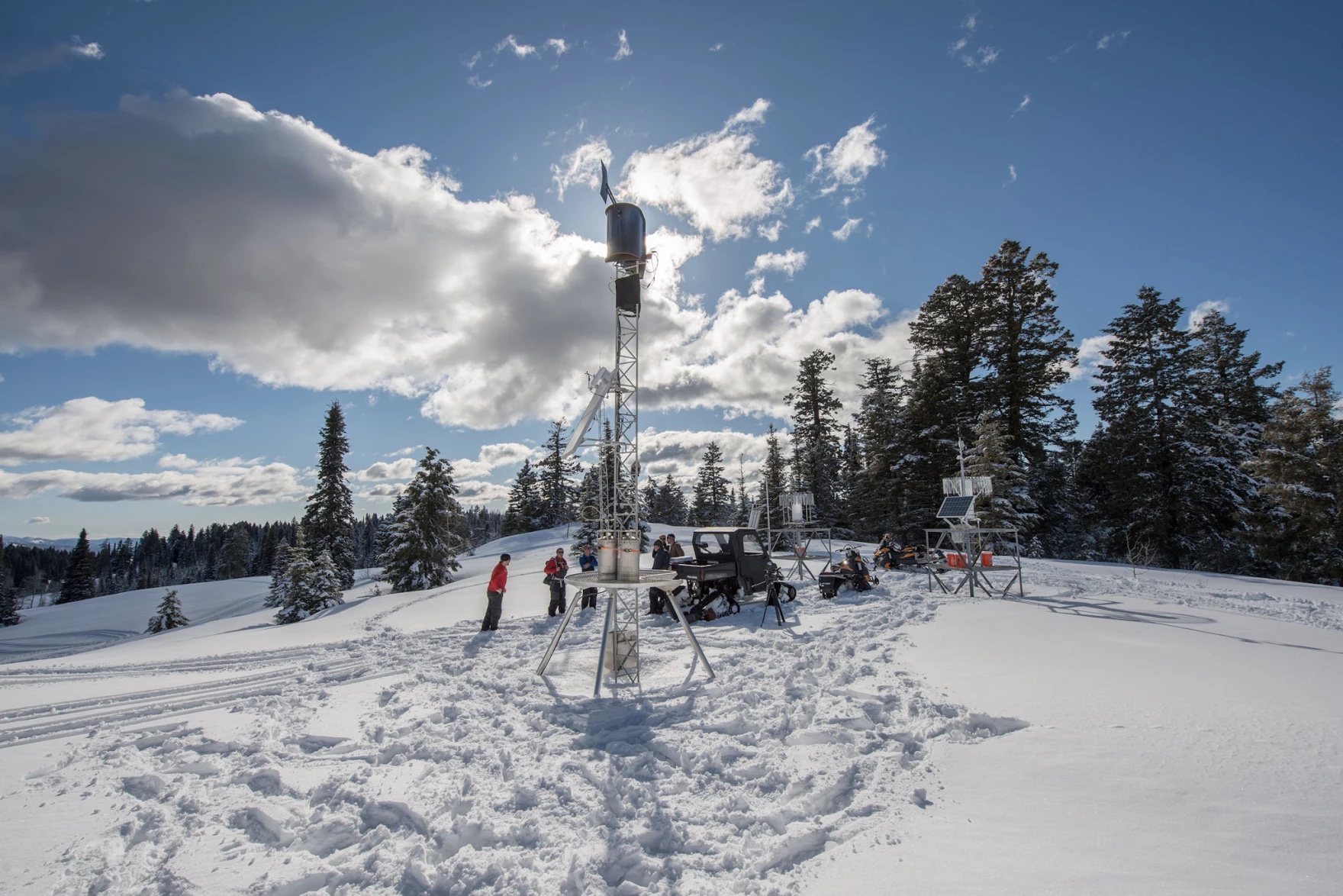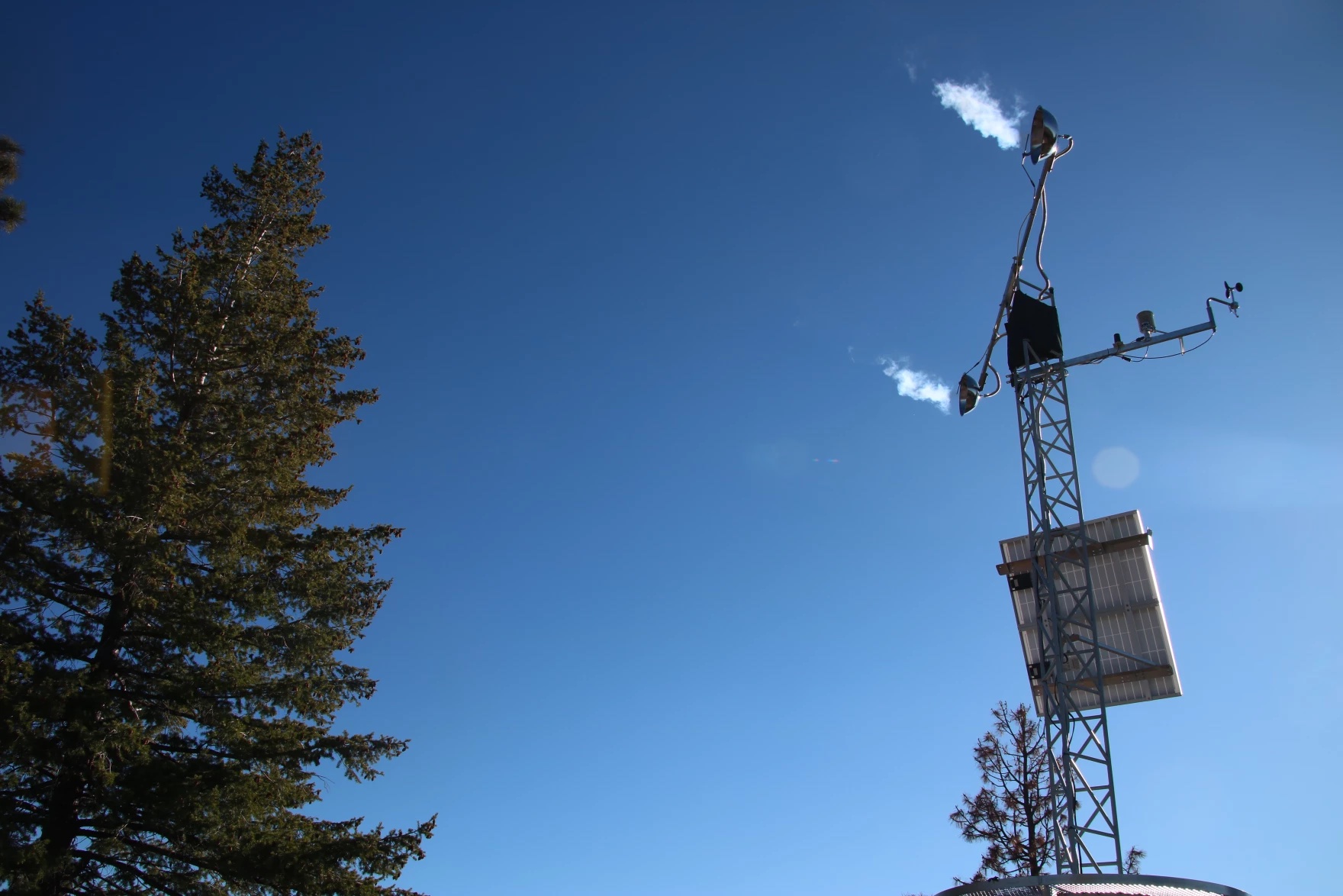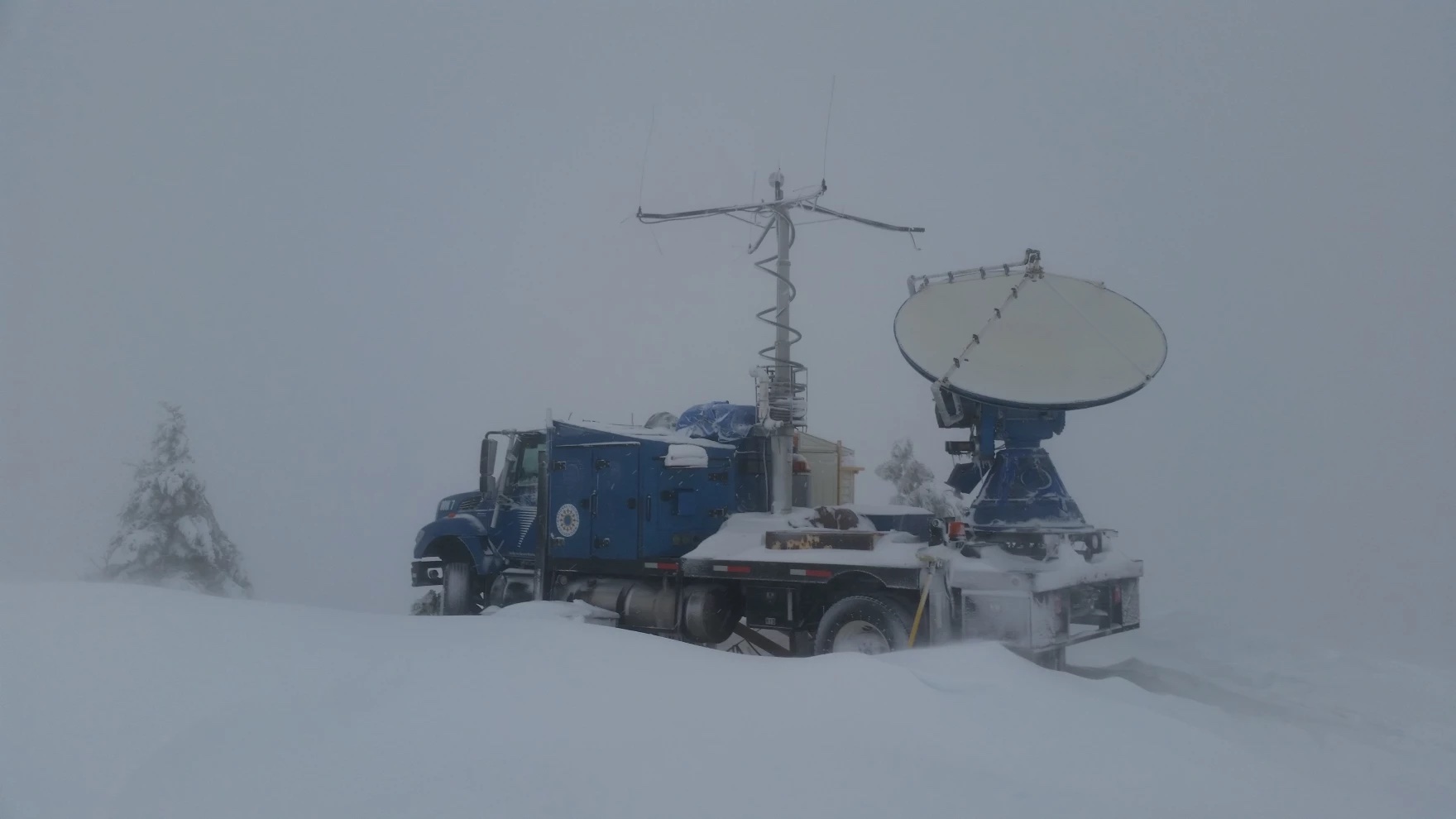A New Recipe For Cloud Seeding To Boost Snowfall In Idaho
5:52 minutes


This article is part of The State of Science, a series featuring science stories from public radio stations across the United States. This story, by Rachel Cohen, was originally published by Boise Public Radio.
We’re taught in school that water freezes at 32 degrees Fahrenheit.
“It usually happens like that in the lake or on the ground,” said Derek Blestrud, a Senior Atmospheric Scientist at Idaho Power.
But the process differs in the sky, he said. Clouds contain supercool water that doesn’t turn to ice until it reaches about -40 degrees F. That is, unless some other substance initiates the freezing.
“Water’s really dumb,” Blestrud likes to say. “It doesn’t know how to freeze unless something else teaches it how to freeze.”
That’s where scientists like Blestrud step in. They help clouds produce more snow through cloud seeding, which involves releasing tiny particles that serve as nuclei for snowflakes to form.
Idaho Power has been cloud seeding since 2003. It now operates 57 remote ground generators in the Payette, Boise, Wood River and upper Snake River basins, and has three airplanes for seeding from the sky, too. For the last decade, the state of Idaho and water users have also contributed funds to the roughly $4 million program.
State water officials estimate this increases snowpack in basins by 10% on average, providing more water for hydropower and crop irrigation.
Scientists first started seeding clouds in the U.S. in the 1940s. Ever since then, they’ve primarily released one compound into clouds to kickstart crystallization: silver iodide. It has a hexagonal structure similar to ice, encouraging more crystals to grow around it.
However, silver iodide has limitations—it requires temperatures below 23 degrees F to work effectively.

That’s why Idaho Power has been experimenting with a new material, liquid propane, that can seed clouds at warmer temperatures.
About a half-mile uphill from its silver iodide generator at ski mountain Bogus Basin, field engineer Brandal Glenn has been refining the company’s prototype of a liquid propane generator for the past few years.
With a remote control, Glenn turns on the machine—a multi-legged metal tower more than 20 feet tall with two salad bowls affixed to a crossarm across the top. The propane — the same you would use for a backyard grill — is pushed to the top and released out of the bowls in misting plumes.
As the liquid propane vaporizes to gas, it cools the air enough for ice to form. Liquid propane can seed clouds when the temperature is below 30 degrees F, about seven degrees warmer than silver iodide.
That means more opportunities to create snow, said Blestrud.
“If you have a liquid propane generator, you have silver iodide generators and you have an aircraft, you can start to target a lot of different storms,” he said.
Idaho Power is introducing liquid propane to its cloud seeding efforts this winter for the first time. The company placed six propane ground generators in the Payette River Basin alongside existing silver iodide ones.
The company hopes that this opens up seeding on the front-end of winter storms, before the temperature plummets, and that it could extend the winter seeding season a week or two on either end.
While liquid propane has long been identified as a potential seeding agent, its usage in cloud seeding operations has been limited. Idaho Power’s program is now the largest.
However, liquid propane isn’t likely to replace silver iodide as the primary seeding agent anytime soon, Blestrud said. For one, it must be released right “in cloud” to produce ice, limiting its use to mountains with certain weather patterns. Additionally, liquid propane won’t alleviate drought conditions, as cloud seeding requires moisture-filled storm clouds already present in the atmosphere.
Still, the state of Idaho is exploring the potential of liquid propane as a seeding agent, too, as it thinks it could prove valuable in a changing climate.

“If we’re having warmer temperatures, then the idea is, potentially, liquid propane could be an opportunity to still maintain the level of efficiency with our program,” said Kala Golden who runs the cloud seeding program for the Idaho Department of Water Resources.
Last year, the state water resource board signed off on more than $1 million toward a project with the National Center for Atmospheric Research (NCAR), in part to identify the best locations for liquid propane seeding. The state and NCAR are investigating spots on the Little Camas Prairie and near Driggs. They hope to pinpoint a good area this year and to begin a four-year study next winter to understand propane’s efficacy and cost-effectiveness.
Sarah Tessendorf, a scientist with NCAR, said some of Idaho’s mountain ranges could serve as ideal test sites.
“They do tend to fall in temperature ranges, especially early winter, late winter, spring time, that might be a little bit too warm for silver iodide seeding,” she said.
Tessendorf noted that this liquid propane research coincides with growing interest in cloud seeding in the West, driven by water scarcity due to drought and climate change.
Last year, Utah significantly boosted its budget for cloud seeding from a couple hundred thousand dollars annually to $5 million, plus $12 million in one-time funds. Similarly, the U.S. Bureau of Reclamation invested $2.4 million in cloud seeding in the Upper Colorado River Basin.

It’s not just grim water shortages fueling interest. A study conducted in Idaho in 2017 called SNOWIE gave scientists the clearest proof yet that cloud seeding works to create additional snow. The researchers seeded a cloud via aircraft that wasn’t naturally producing ice.
“We were using radars and precipitation gauges, and we were able to gain clear evidence of the precipitation enhancement,” said Tessendorf, who was a principal investigator on the project. “That had been something that was quite a challenge for the prior many decades of research.”
Although the SNOWIE study was a significant breakthrough, questions remain about the quantity of precipitation cloud seeding can produce and the translation of the project’s results to other areas.
As for environmental implications, Tessendorf said numerous studies show minimal impact from silver iodide, and similar results have been found for liquid propane.
“Car pollution, industrial pollution, there’s a lot of other sources that are far greater than what we’re producing from cloud seeding, which is done on very small scales and limited time frames,” she said.
But, she said it’s important to continue monitoring as cloud seeding operations expand.
Tessendorf sees new developments like the liquid propane study in Idaho as extensions of the SNOWIE research.
“It’s a really exciting time to be in this field of research because we’ve got new advances to be able to help us answer some of these long-standing questions,” she said.
Golden, too, expressed eagerness that Idaho is at the forefront of looking into these questions, and hopes the answers will provide another way to bolster water supply on the ground.
Invest in quality science journalism by making a donation to Science Friday.
Rachel Cohen is an environment and outdoors reporter with Boise State Public Radio in Boise, Idaho.
SOPHIE BUSHWICK: This is Science Friday. I’m Sophie Bushwick.
KATHLEEN DAVIS: And I’m Kathleen Davis. And now it’s time to check in on the state of science.
[RADIO STATIC]
SPEAKER 1: This is KERN.
SPEAKER 2: For WWNO–
SPEAKER 3: Saint Louis Public Radio.
SPEAKER 4: Iowa Public Radio News.
KATHLEEN DAVIS: Local science stories of national significance– for decades, scientists have used a technique called cloud seeding to create snow. This could be a big boost for states that need more precipitation, whether that’s for hydropower or for crop irrigation. But researchers in Idaho have found a new, better way to seed clouds, which may have a big impact as the climate changes. So joining me to talk about this story is my guest, Rachel Cohen, Environment and Outdoors Reporter for Boise State Public Radio, based in Boise Idaho. Welcome to Science Friday, Rachel.
RACHEL COHEN: Hi. Thanks for having me.
KATHLEEN DAVIS: So cloud seeding is not a new concept, but can you walk me through how this traditionally works?
RACHEL COHEN: Yeah. Scientists have been cloud seeding since about the 1940s to boost rainfall, prevent hailstorms, and in the Western US to increase winter snowfall in the mountains. And the way it works is that clouds contain tiny water droplets that don’t freeze until it gets really, really cold. But scientists can get this water to freeze earlier if they add some particle to the mix that creates a nucleus for the ice to form around.
And for the most part, scientists have used one compound to kick start this ice-forming process in clouds, and that’s called silver iodide. And silver iodide has a shape that’s similar to ice crystals, so it encourages them to grow. And when storms move through an area, scientists can release small amounts of silver iodide from generators on the ground, usually high up in the mountains or from plains. And when the silver iodide reaches the cloud, it helps the cloud produce snowflakes that otherwise might not have formed.
KATHLEEN DAVIS: OK. So tell me about this new method of cloud seeding that Idaho scientists think could work a lot better.
RACHEL COHEN: In Idaho, the electric utility, Idaho Power, does much of the cloud seeding because it relies on water for hydropower. And Idaho Power has been cloud seeding in Idaho for about two decades with silver iodide. But this year, it’s doing something new. It’s added generators that release a new material– liquid propane.
And releasing liquid propane in some cases instead of silver iodide can help it create more snowfall because liquid propane works up to about 30 degrees Fahrenheit, which is about 7 degrees warmer than silver iodide. So liquid propane actually works to create ice a bit differently than silver iodide. It cools the temperature in the air down to where the water in the clouds will freeze on its own.
KATHLEEN DAVIS: So how much could cloud seeding in this new way actually contribute to Idaho’s snowpack?
RACHEL COHEN: Scientists have estimated that silver iodide seeding can increase precipitation in a season by about 10%, on average. But Idaho Power is really on the forefront of using liquid propane in a larger operational setting, so it’s still too early to know what sort of effect it will have on snowfall. But the company says using liquid propane could help it seed on the front end of winter storms, which tend to roll in a bit warmer before the temperature drops. And it could also extend the winter seeding season by about a week or two on either end.
And I spoke with Sarah Tessendorf. She’s a scientist at the National Center for Atmospheric Research in Colorado. And she says Idaho could be a good place to explore some of these questions about this newer cloud-seeding technology. Many mountain ranges in Idaho aren’t as high in elevation as some of the other places in the Rockies, and so they do tend to fall in temperature ranges, especially early winter or late winter/spring time that might be a little bit too warm for silver iodide seeding.
KATHLEEN DAVIS: So this isn’t just something that’s happening in Idaho, right? I mean, what’s the national demand for cloud seeding?
RACHEL COHEN: Yeah. Cloud seeding happens all over the world, actually. And in the Western US, it’s going on in at least seven states. But demand is growing. With climate change and ongoing drought, many areas just don’t have the water they need to meet demand from farmers, energy production, cities.
And so water managers are under a lot of pressure to conserve water, but also look to technologies like cloud seeding that could give their area boost. And so now some states that haven’t cloud seeded in the past are exploring it. Montana is conducting a pilot study, and other states are expanding their programs, like Utah drastically increased its annual cloud-seeding budget from just a couple $100,000 to $5 million.
KATHLEEN DAVIS: Do scientists think that this is a long-term solution?
RACHEL COHEN: Water managers are quick to say cloud seeding is not a silver-bullet solution. It’s just another tool in the toolbox. But scientists emphasize that you can’t cloud seed your way out of a drought because you need storms to cloud seed, and specifically ones with clouds that already have moisture.
KATHLEEN DAVIS: Well, that’s all the time that we have for now. I’d like to thank my guest, Rachel Cohen, Environment and Outdoors Reporter for Boise State Public Radio based in Boise Idaho. Thank you so much for bringing us this story.
RACHEL COHEN: Thank you for having me.
Copyright © 2023 Science Friday Initiative. All rights reserved. Science Friday transcripts are produced on a tight deadline by 3Play Media. Fidelity to the original aired/published audio or video file might vary, and text might be updated or amended in the future. For the authoritative record of Science Friday’s programming, please visit the original aired/published recording. For terms of use and more information, visit our policies pages at http://www.sciencefriday.com/about/policies/
Kathleen Davis is a producer and fill-in host at Science Friday, which means she spends her weeks researching, writing, editing, and sometimes talking into a microphone. She’s always eager to talk about freshwater lakes and Coney Island diners.